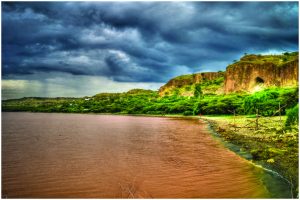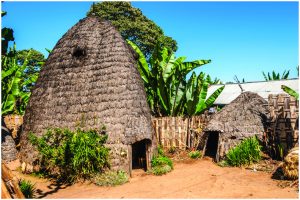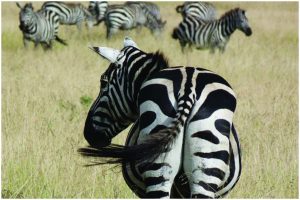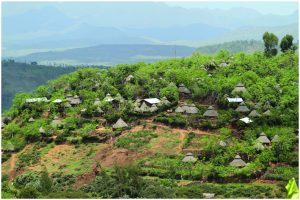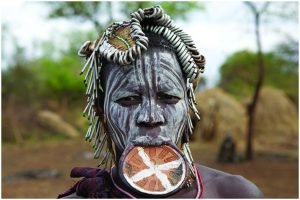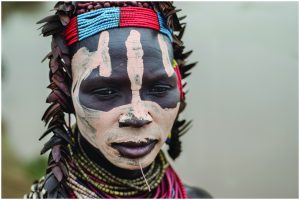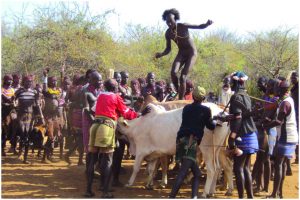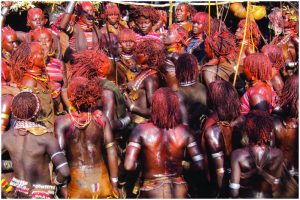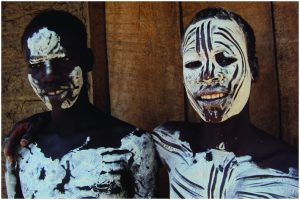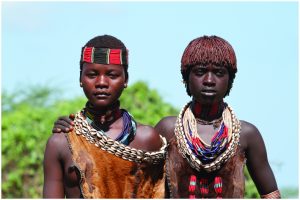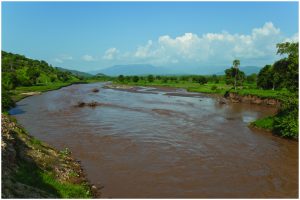Colorful People of the South Omo Valley
This one week tour introduces you to the various people living in the deep South Omo Valley of Ethiopia. You’ll start your tour in Addis Ababa and drive south towards Arbaminch to enjoy the wildlife of Nechisar National Park before you continue your way to Turmi and Jinka. On the last day, you’ll fly back to the capital from Arbaminch.
Day 1 – Arrival in Addis Ababa
Depending on your flight you will have time for a city tour through Addis Ababa. Spend the night in Addis Ababa.
Day 2 – From Addis Ababa to Dorze
Start the day early because it is a long way down south. However, the landscape will make you enjoy the trip and let the time fly by. Because you reach Arbaminch, the biggest town and entrance to the South Omo Valley you will visit the Dorze people who live in a village up the mountains. In the Dorze village you will get the possibility to experience the traditional way of life of the Dorze people including special food, different architecture (bamboo elephant houses), weaving, a coffee ceremony, traditional alcohol, and you can take part in traditional dances yourself (it’s a lot of fun and a few shots of Arake before help to get ready). Don’t be shy and shake your booty to the Dorze rhythms. Spend the night in a small traditional hut in the Dorze Village.
Day 3 – Lake Chamo and Nechisar National Park around Arbaminch
Drive back to Arbaminch for a proper breakfast in one of the hotels and check in for the following night. After filling yourself you’ll take a short drive to the shore of Lake Chamo to take a boat ride across the lake. In the mornings you can watch the big Nile crocodiles that are sunbathing close to the shore. You will also be able to watch hippos, pelicans and many other colorful as well as seldom birds. After crossing the lake, you can hike up into Nechisar National Park to watch zebras, kudus, warthogs and gazelles. Take a lunch box from the hotel and enjoy the amazing view on the lake and the grass plains at the same time. You will be back in the late afternoon. Spend the night in Arbaminch.
Day 4 – Arbaminch via Konso to Jinka
Drive from Arbaminch to Konso and stop in between to visit local markets. Konso has a special way of building up its traditional village through which you will get a guided tour. The way of life and culture from the Konso people is very unique and it’s interesting to listen to the local guide who can answer all your questions. In the late afternoon, you will arrive in Jinka which is the entrance town to the Mago National Park where you can get to know the Mursi people.
Day 5 – Mago National Park to Turmi
Today you will drive deep into Mago National Park to visit a local village of the Mursi people. The 8,000 Mursi people are next to the Hamer the most popular in Ethiopia’s Omo Valley. They are well known for their unique lip plates. They are settled around the Omo River and in the Mago National Park. Due to the climate, they move twice a year between the winter and summer months. They herd cattle and grow crops along the banks of the Omo River. The Mursi women paint their bodies and face in white. They also are the ones who wear the lip plates. Women of the Mursi tribe may have their lips cut at the age of 15 or 16. A small clay plate is then inserted into the lip. Through the years, larger plates are inserted into the lip causing it to stretch. The larger the clay plate, the more the woman is worth before she gets married. It is said that the clay plates were originally used to prevent capture by slave traders. Although very unique and part of their tradition, the Mursi women only wear the plates for a short time because they are so heavy and uncomfortable. Men of the Mursi use white paint for their bodies and faces. Just like any other ethnic tribe in the lower valley, the men must pass a test before they can get married. A Mursi man is given a stick called a Donga and must face an opponent. The men then battle it out, beating each other with the sticks. The first fighter to submit loses and the winner is taken by a group of women to determine who he will marry. Men of the tribe also practice scarification. Like other tribes, this is the marking of an enemy killed by him. Although they are known to be aggressive and combative, the Mursi are more than happy to allow you to take pictures of them. However, they keep count of every picture taken and will charge you for each one. In the afternoon you will continue your drive to Turmi which is the central town on the Hammer people. Spend the night in Turmi.
Day 6 – Turmi, surrounding villages and Karo tribe
You can drive closer to the Omo River to visit the very friendly Karo tribe. The Karo is a small tribe with an estimated population between 1,000 and 3,000. They live along the east banks of the Omo River and practice flood retreat cultivation. The crops that are grown by them are sorghum, maize and beans. Only small cattle are kept because of the tsetse flies. These flies are large and consume the blood of vertebrate animals. Like many of the tribes in the Omo, they paint their bodies and faces with white chalk to prepare for a ceremony. The chalk is mixed with yellow rock, red iron ore and charcoal to make its color. Face masks are worn at times and they have clay hair buns with feathers in them. Red clay mixed with butter is put into their hair and clothing is made from animal skin. The women scar their chest believing it makes them beautiful. The men’s scars represent that an enemy or dangerous animal has been killed. They also wear clay hair buns which symbolize a kill. A man in the tribe can have as many wives as he wants, but must be able to afford them. Most men will only marry two or three. In the early evening you can visit a village of the Hamer people around Turmi. They are one of the most known tribes in Southern Ethiopia and amount to about 40,000 people. They inhabit the territory east of the Omo River and have villages around Turmi and Dimeka. Tourists visit the Hammer hoping to see a traditional leaping ceremony, which is the jumping over bulls, an initiation ceremony for young men. The Hammer are cattle herders and practice agriculture. Very colorful bracelets and beads are worn in their hair and around their waists and arms. The practice of body modification is used by cutting themselves and packing the wound with ash and charcoal. Some of the women wear circular wedge necklaces indicating that they are married. If you are lucky an initiation ceremony for a young Hammer man takes place. The traditional bull jumping is a rite of passage for men coming of age. The event last three days and involves only castrated cattle. The man must jump over a line of usually seven bulls four times completely nude without falling. If this task is complete, the man joins the ranks of the Maza. Maza are men that have successfully completed the bull jumping event. During this ceremony, the women of the tribe provoke the maza to whip them on their bare backs. This is extremely painful and causes severe scaring on the women. The scars are a symbol of devotion to the men and are encouraged by the tribe. Night dancing called evangadi is also a Hammer tradition and very worth experiencing. During your tour through the South Omo Valley we will find out whether celebrations like the bull jumping ceremony or the evangadi dance take place. Although chances are usually good to see at least one of the ceremonies, these events cannot be guaranteed. Spend the night in Turmi. Spend the night in Turmi.
Day 7 – Turmi via Arbaminch to Addis Ababa
Get an early start to drive back to Arbaminch. You need to catch the flight with Ethiopian Airlines just after lunch to be back in Addis Ababa in the late afternoon. We will end the tour with a farewell dinner in a cultural restaurant where you can enjoy great Ethiopian food together with traditional music and dances from all over the country. The tour ends in Addis Ababa.
I am text block. Click edit button to change this text. Lorem ipsum dolor sit amet, consectetur adipiscing elit. Ut elit tellus, luctus nec ullamcorper mattis, pulvinar dapibus leo.

